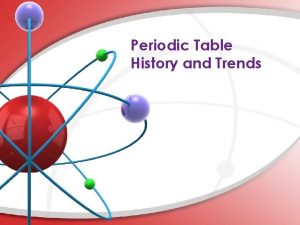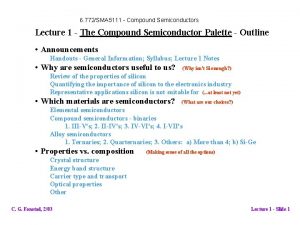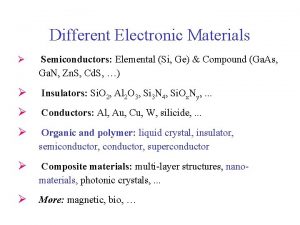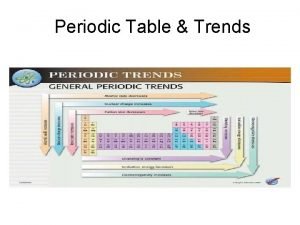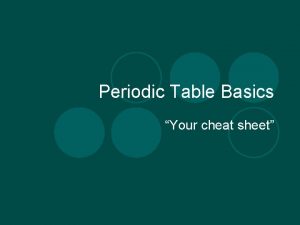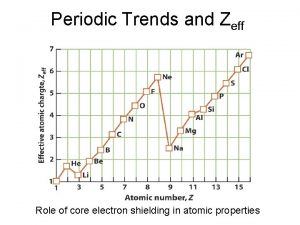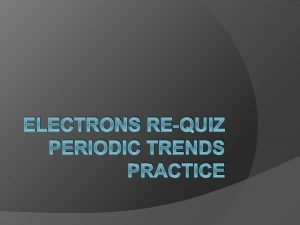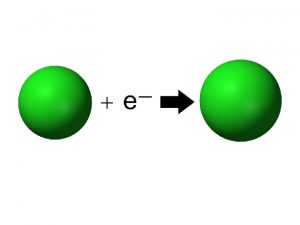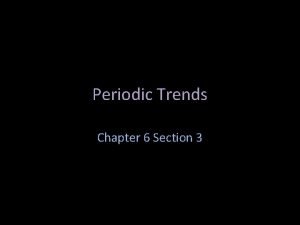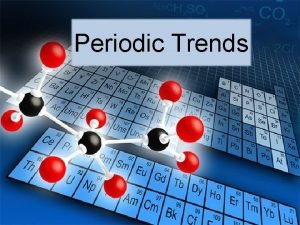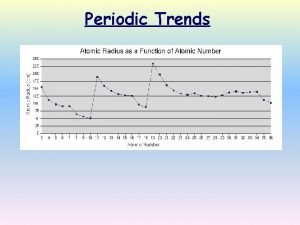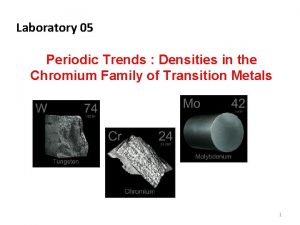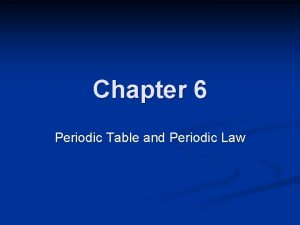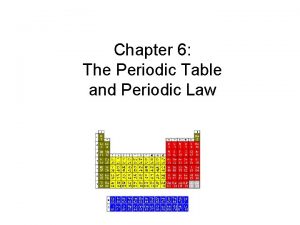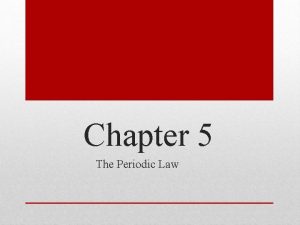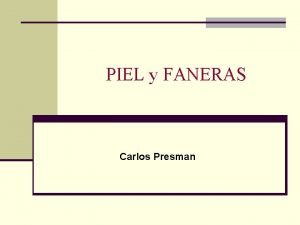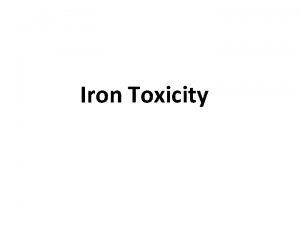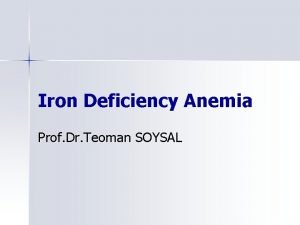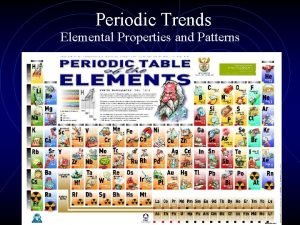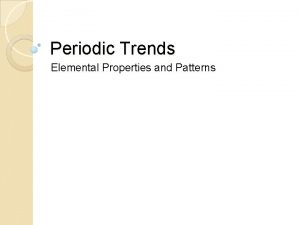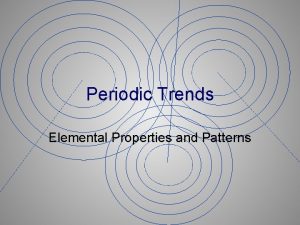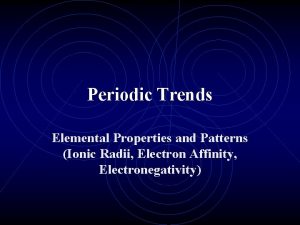Periodic Trends Elemental Properties and Patterns I CAN















































- Slides: 47

Periodic Trends Elemental Properties and Patterns

• I CAN use the PT to predict a number of properties among the elements.

The Periodic Law • Though he didn’t realize it at the time, Mendeleev made an important discovery about the elements. • Mendeleev’s repeating patterns on his Periodic Table led to the formulation of the ‘Periodic Law’ which states: • When arranged by increasing atomic number, the chemical elements display a regular and repeating pattern of chemical and physical properties.

What Does the Periodic Table Tell Us? • Recall that the blocks of the periodic table arranged in to LEFT TO RIGHT ROWS called a PERIOD/SERIES and UP AND DOWN COLUMNS called a FAMILY/GROUP. • Each square on the periodic table is known as an ELEMENT KEY and provides the basic information about each element: • CHEMICAL SYMBOL – a one or two letter abbreviation for the name of an element. – Some symbols are based on the Greek or Latin name of the element. • Example Lead = Pb from Plumbus (where we get plumber from). • Gold = Au from Arium (to shine like the sun).

• ELEMENT NAME – the name of the element. – Some names are more than two thousand years old! • ATOMIC NUMBER – Number of protons (nucleus) or electrons (electron cloud). • ATOMIC MASS NUMBER – combined number of protons and neutrons in the nucleus.

VALENCE ELECTRONS • One of the most important thing about an atom is the number of VALENCE ELECTRONS it has. • Valence Electrons are those electrons found on the outside edge of the atom, farthest away from the nucleus.

Valence Electrons are those on the outer edge of the atom.

• An atom will have from 1 to 8 valence electrons, abbreviated as Ve-. • Valence electrons are used to bond to other atoms to form COMPOUNDS.

Valence Electrons • Determining the number of Valence Electrons an element has is easy: • Look at the GROUP NUMBER the element is in. • Remember the GROUP NUMBER is the numbers 1 to 18 across the tops of the vertical columns. • IGNORE the TRANSITION ELEMENTS (groups 3 -12) for now. • ONLY LOOK AT GROUPS 1, 2, 13, 14, 15, 16, 17 and 18.

• The number of Valence Electrons is from the group number (Groups 13 -18 just use the SECOND number): • Group 1 = 1 Ve • Group 2 = 2 Ve • Group 13 = 3 Ve • Group 14 = 4 Ve • Group 15 = 5 Ve • Group 16 = 6 Ve • Group 17 = 7 Ve • Group 18 = 8 Ve • We will learn the Transition Elements later!

PRACTICE PROBLEMS • Look at the questions on the back of this packet. • Use the periodic table on the NEXT problems. SLIDE, to complete these • I. FIND THE ELEMENT – use the period/series and family/group information given in each statement to find the element referred to on the Periodic Table. • II. HOW MANY VALENCE ELECTRONS – use the position of each element on the Periodic Table to determine how many Valence Electrons each element has.

If you can’t read this table, follow this link to display it online: http: //www. ptable. com/Images/periodic%20 table. png

• • • • • • • I. FIND THE ELEMENT – use the period/series and family/group information given in each statement to find the element referred to on the Periodic Table. a. Period 3 Group 15 ___________ b. Period 6 Group 12 ____________ c. Period 2 Group 17 ___________ d. Period 3 Group 2 _____________ e. Period 7 Group 11 ___________ f. Period 4 Group 16 ____________ g. Period 1 Group 18 ____________ h. Period 3 Group 13 ____________ i. Period 5 Group 4 ____________ j. Period 4 Group 2 _____________ k. Period 6 Group 14 ___________ l. Period 4 Group 16 _____________ m. Period 3 Group 14 ___________ n. Period 6 Group 11 ____________ II. HOW MANY VALENCE ELECTRONS – use the position of each element on the Periodic Table to determine how many Ve- each element has. o. Hydrogen ______ p. Iodine ____ q. Calcium ______ r. Oxygen _______ s. Boron _____ t. Magnesium _____ u. Francium _____ v. Tin ______ w. Carbon ____ x. Xenon _____ y. Sulfur _______ z. Potassium _____

• STOP HERE

Grouping the Elements • • Elements are often classified by their type: Metals Nonmetals Metalloids or Semi-metals • The following slide shows where each group is found.

Metals, Nonmetals, Metalloids

Metals, Nonmetals, Metalloids • There is a zig-zag or staircase line that divides the table. • Metals are on the left of the line, in blue. • Nonmetals are on the right of the line, in orange.

Metals, Nonmetals, Metalloids • Elements that border the stair case, shown in purple are the metalloids or semimetals. • There is one important exception. • Aluminum is more metallic than not.

Metals, Nonmetals, Metalloids • • • How can you identify a metal? What are its properties? What about the less common nonmetals? What are their properties? And what is a metalloid?

Metals are: Lustrous Have a shiny surface. Malleable Can be hammered thin. Ductile Can be stretched (wire) Good Conductors Allow heat and electricity to flow through easily. • They are mostly solids at room temp. • What is one exception? • Mercury (Hg) is a LIQUID metal! • • •

Nonmetals • Nonmetal properties are the basically opposite of metals: • Dull • Not shiny/can’t be polished. • Brittle • Break easily…cannot be hammered thin. • Poor/non-conductors • Limited or no flow of heat or electricity through them. – (also called insulators). • Some are solid, several are gases, and BROMINE is a liquid.

Metalloids • Metalloids, aka semi-metals are just that. • They have characteristics of both metals and nonmetals. • They are shiny but brittle. • They are semiconductors: elements that have conduction capacities between non metals and metals. • What are our most important semiconductors? • Silicon, Germanium, and Arsenic.

Periodic Trends • ATOMIC RADIUS • The first and most important is atomic radius. • Radius is the distance from the center of the nucleus to the “edge” of the electron cloud.

Atomic Radius • Since a cloud’s edge is difficult to define, scientists use a defined covalent radius, or half the distance between the nuclei of 2 bonded atoms. • Atomic radii are usually measured in picometers (pm = 1 x 10 -9 m) or angstroms (Å). An angstrom is 1 x 10 -10 m.

Example of Covalent Radius • Two Br atoms bonded together are 2. 86 angstroms apart. 2. 86 Å • Arad = 2. 86 Å = 1. 43 Å 2 •

Atomic Radius • The trend for atomic radius in a FAMILY/GROUP (vertical column) is to go from smaller at the top to larger at the bottom of the family. • Why? • With each step down the family, we add an entirely new PEL to the electron cloud, making the atoms larger with each step.

Atomic Radius • What happens to atomic structure as we step from left to right? • Each step adds a proton and an electron (and 1 or 2 neutrons).

Atomic Radius • The effect is that the more positive nucleus has a greater pull on the electron cloud. • The nucleus is more positive and the electron cloud is more negative. • The increased attraction pulls the cloud in closer to the nucleus, making atoms smaller as we move from left to right across a period.

INCREASES TOWARD BOTTOM LEFT Overall Trend of Atomic Radius DECREASES TOWARD TOP RIGHT

e- Shielding • As more PELs are added to atoms, the inner levels of electrons shield the outer electrons from the nucleus’ attraction. • The effective nuclear attraction for these outer electrons is less, and so the outer electrons are less tightly held. • This makes it easier to remove some of these e- when bonding to other atoms.

Ionization Energy • This is the second important periodic trend. • If an electron is pulled toward another atom with enough energy to overcome the effective nuclear attraction of the parent atom holding the electron in the cloud, it can leave the atom completely. • Once an electron has been removed from one atom and added to another, both atoms are changed. • These atoms have been “ionized”. • The number of protons and electrons is no longer equal. • The atom that lost an electron becomes POSITIVELY charged (more P+ than e-) while the atom that gained an electron becomes NEGATIVELY charged (more e- than P+ ).

Ionization Energy • The energy required to remove an electron from an atom is ionization energy. • The larger the atom is, the easier its electrons are to remove. • Ionization energy and atomic radius are inversely proportional. • Ionization energy is always endothermic, that is energy is added to the atom to remove the electron.

Ionization Energy • Draw arrows on your help sheet like this: INCREASES LEFT TO RIGHT DECREASES DOWNWARD TOP TO BOTTOM

Electron Affinity • What does the word ‘affinity’ mean? • Electron affinity is the energy change that occurs when an atom gains an electron (also measured in k. J). • Where ionization energy is always endothermic, electron affinity is usually exothermic, but not always.

Electron Affinity • Electron affinity is exothermic if there is an empty or partially empty orbital for an electron to occupy. • If there are no empty spaces, a new orbital or PEL must be created, making the process endothermic. • This is true for the alkaline earth metals and the noble gases.

Electron Affinity • Your help sheet should look like this: + +

Metallic Character • This is simple a relative measure of how easily atoms lose or give up electrons. • Your help sheet should look like this:

Electronegativity • Electronegativity is a measure of an atom’s attraction for another atom’s electrons. • It is an arbitrary scale that ranges from 0 to 4. • The units of electronegativity are Paulings. • Generally, metals are electron givers and have low electronegativities. • Nonmetals are electron takers and have high electronegativities. • What about the noble gases?

Electronegativity • Your help sheet should look like this: 0

Overall Reactivity • This ties all the previous trends together in one package. • However, we must treat metals and nonmetals separately. • The most reactive metals are the largest since they are the best electron givers. • The most reactive nonmetals are the smallest ones, the best electron takers.

Overall Reactivity • Your help sheet will look like this: 0

The Octet Rule • The “goal” of most atoms (except H, Li and Be) is to have an octet or group of 8 electrons in their valence energy level. • They may accomplish this by either giving electrons away or taking them. • Metals generally give electrons, nonmetals take them from other atoms. • Atoms that have gained or lost electrons are called ions.

Ions • When an atom gains an electron, it becomes negatively charged (more electrons than protons ) and is called an anion. • In the same way that nonmetal atoms can gain electrons, metal atoms can lose electrons. • They become positively charged cations.

Ions • Here is a simple way to remember which is the cation and which the anion: + This is Ann Ion. She’s unhappy and negative. + This is a cat-ion. He’s a “plussy” cat!

Ionic Radius • Cations are always smaller than the original atom. • The entire outer PEL is removed during ionization. • Conversely, anions are always larger than the original atom. • Electrons are added to the outer PEL.

Cation Formation Effective nuclear charge on remaining electrons increases. Na atom 1 valence electron 11 p+ Valence elost in ion formation Result: a smaller sodium cation, Na+ Remaining e- are pulled in closer to the nucleus. Ionic size decreases.

Anion Formation Chlorine atom with 7 valence e 17 p+ One e- is added to the outer shell. Effective nuclear charge is reduced and the e- cloud expands. A chloride ion is produced. It is larger than the original atom.
 Periodic trends in elemental properties
Periodic trends in elemental properties Periodic trends in elemental properties
Periodic trends in elemental properties Periodic trends in elemental properties
Periodic trends in elemental properties Patterns in the periodic table
Patterns in the periodic table Alien periodic table periodic trends answers
Alien periodic table periodic trends answers Periodic trends in properties of elements
Periodic trends in properties of elements A visual aid used to show statistical trends and patterns
A visual aid used to show statistical trends and patterns A visual aid used to show statistical trends and patterns
A visual aid used to show statistical trends and patterns Elemental and compound semiconductors
Elemental and compound semiconductors Elemental and compound semiconductors
Elemental and compound semiconductors Ionic radius trends
Ionic radius trends Ptable trends
Ptable trends Periodic table of elements cheat sheet
Periodic table of elements cheat sheet Ap chemistry chapter 7 atomic structure and periodicity
Ap chemistry chapter 7 atomic structure and periodicity Graphing periodic trends
Graphing periodic trends Oxidation trends periodic table
Oxidation trends periodic table Periodic trend definition
Periodic trend definition Zeff trend in periodic table
Zeff trend in periodic table Periodic trends activity worksheet
Periodic trends activity worksheet Periodic trends practice quiz
Periodic trends practice quiz Periodic trends in reactivity
Periodic trends in reactivity Summary of periodic trends
Summary of periodic trends Ionization energy practice problems
Ionization energy practice problems Coulomb's law electronegativity
Coulomb's law electronegativity Electron affinity trend
Electron affinity trend Increasing atomic size
Increasing atomic size Atomic radii periodic table
Atomic radii periodic table Periodic trends definition
Periodic trends definition Acidity trends periodic table
Acidity trends periodic table Trends in periodic table
Trends in periodic table Periodic trends
Periodic trends Periodic table with properties
Periodic table with properties Ionisation energy and atomic radius
Ionisation energy and atomic radius Periodic trends game
Periodic trends game Definition of atomic radius
Definition of atomic radius Density periodic trend
Density periodic trend Periodic trends assignment
Periodic trends assignment Periodic trends
Periodic trends Chapter 6 periodic table
Chapter 6 periodic table The periodic table and periodic law chapter 6
The periodic table and periodic law chapter 6 Chapter 5 periodic law
Chapter 5 periodic law X videos
X videos How understanding of motion elements and principles
How understanding of motion elements and principles Elemental analysis of beer
Elemental analysis of beer Unidad elemental
Unidad elemental Saproficias
Saproficias Elemental iron dose
Elemental iron dose Teoman soysal
Teoman soysal





